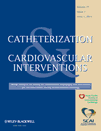Usage patterns and 1-year outcomes with the TAXUS Liberté stent: Results of the TAXUS OLYMPIA registry†
Conflict of interest: The authors wish to disclose the following conflicts of interest related to the manuscript: W. Ahmed, research grant/advisory board (Boston Scientific, Abbott); O. Mendiz, research grant (Boston Scientific, CRF, Cordis); and M. Thomas, consultant/advisory board (Boston Scientific, Cordis).
Abstract
Objectives: The TAXUS OLYMPIA registry is a prospective, global, post-approval program designed to collect clinical outcome data through 1 year from patients receiving the TAXUS Liberté paclitaxel-eluting stent in routine interventional cardiology practice. Background: The thin-strut TAXUS Liberté stent has been studied in ongoing clinical trials with specific inclusion/exclusion criteria. Methods: Between September 2005 and April 2007, a total of 21,954 patients from 365 sites in 57 countries eligible to receive a TAXUS Liberté stent were enrolled in the TAXUS OLYMPIA registry. Baseline characteristics and procedure patterns were collected and clinical follow-up is available for 1 year. The primary endpoint was the composite cardiac event (cardiac death, MI, and reintervention of the target vessel) rate related to the TAXUS Liberté stent at 1 year. All cardiac events were monitored and all endpoints were independently adjudicated. Results: Complex patients and lesions were prevalent, including: 27% medically-treated diabetes, 58% ACC/AHA type B2/C lesions, 32% multiple stenting, 13% long lesions (>28 mm), and 10% small vessels (<2.5 mm). At 1 year, the composite cardiac event rate was 4.4%, including 1.4% cardiac death, 1.0% MI, and 3.2% TVR. Stent thrombosis (ST, angiographically confirmed) occurred in 0.8% of patients, with 0.4% ST occurring >30 days postprocedure. The composite cardiac event rate related to the TAXUS Liberté stent was 3.8% at 1 year. Conclusions: Low 1-year cardiac event rates were reported with TAXUS Liberté in a broad spectrum of patients, thereby confirming the technical and clinical performance of this stent in a “real-world” setting. © 2010 Wiley-Liss, Inc.




